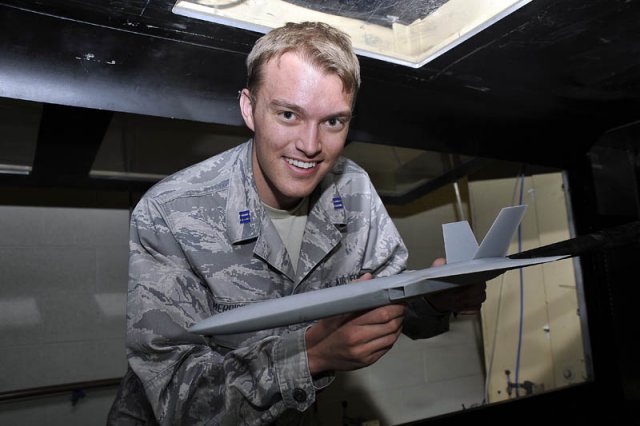
Cadet 1st Class Justin Merrick from the Air Force Academy's Cadet Squadron 20 shows the drone developed in the Aerospace Lab
A small target drone designed by a group of Air Force Academy cadets could become the Air Force’s newest unmanned aircraft.
Its mission: become a target for F-22s and F-35s to shoot down during training. The Air Force is considering the small unmanned aircraft along with another one by a contractor.
More than 50 groups of cadets submitted potential designs for the new drone as part of a “capstone course” in 2008, during their final year at the academy.
The academy — along with partners at the Air Force Research Laboratory, the service’s Aeronautical Systems Center and the contractor Sierra Technical Services — has been researching since 2003 what sort of drone the service could use to practice shootdowns.
The Air Force now uses F-4s that have been modified as drones — QF-4s — for that training. F-16s, modified as drones and renamed QF-16s, are scheduled to replace them soon, but using modified fighters could pose a disadvantage.
“It’s possible that other countries will, in the near future, have fighters that are stealthy. The QF-4 and the QF-16 aren’t stealthy,” said Steve Brandt, a professor of aeronautics at the academy. “All U.S. weapons systems have to be tested under realistic conditions before they’re fielded, and if we really think that other countries are going to have stealthy fighter airplanes, then testing those missiles against QF-4s and QF-16s may not be adequate.”
The 2008 design by cadets has remained in the running to become the service’s next drone in large part because it’s so simple, Brandt said. The 40-foot-long drone is stable and sleek, flying with two T-38 engines and a 24-foot-long wingspan.
“The big thing about the cadet design is that it’s simple, which we hope will translate to low cost,” he said. “The whole idea is there’s less components, so it’s going to cost less to build.”
A price for the drone hasn’t been determined yet. A target price is $3.5 million, the cost of the QF-16 in 2009, but that might not be possible, Brandt said.
There’s also no definitive timeline right now for when a design will be selected or when the first new drone could hit the fleet, but Brandt estimates that it will take a while because of the natural pace of aircraft development and the tightening defense budget.
“Trying to see the future is a little hard,” he said. “About all we know for sure right now is that the cadet design has survived a lot of subsequent development and is still pretty much in its original form.”
Cadets haven’t just been involved in the design process. They’ve also been testing drone models in one of the academy’s four wind tunnels. Giving future airmen the ability to work on multiple steps of an aircraft’s development has given them a good beginning to their Air Force careers, Brandt said.
“Because they’re all future Air Force officers, I hope they’ll bring a better appreciation for the role of aircraft design and aircraft companies in creating our Air Force’s capabilities,” he said.
Source: Air Force Times
